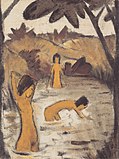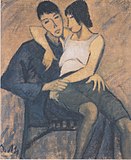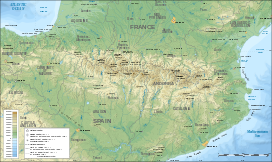오토 뮬러
Otto Mueller오토 뮬러 | |
|---|---|
 오토 뮐러, 자화상, c. 1921, 세인트루이스 미술관 | |
| 태어난 | 16 1874년 10월 |
| 죽은 | 1930년 9월 25일 (55세) |
| 국적 | 독일어 |
| 교육 | 뮌헨 드레스덴 미술 아카데미 |
| 로 알려져 있다. | 그림 그리기, 인쇄 |
| 스타일 | 표현주의 |
| 움직임 | 다이 브뤼케 |
오토 뮐러(Otto Müller, 1874년 10월 16일 ~ 1930년 9월 24일)는 독일의 화가 겸 인쇄업자였다.
삶과 일
뮬러는 실레시아 크레이스 란데슈트 주 리바우(현 카미엔나 고라군 루바우카)에서 태어났다. 1890년과 1892년 사이에 괴를리츠와 브레슬라우에서 석판술 교육을 받았다. 1894년부터 1896년까지 그는 드레스덴의 미술 아카데미에서 공부했고 1898년 동안 뮌헨에서 공부를 계속했다. 그는 프란츠 폰 스틱이 그를 무자격자로 분류한 후 뮌헨의 학원을 떠났다.
그의 초기 작품들은 인상주의, 주겐스틸, 상징주의의 영향을 받는다. 1908년 베를린에 정착하면서 그의 스타일은 더욱 표현주의적이 되었다. 이 기간 동안 빌헬름 렘브룩, 라이너 마리아 릴케, 에리히 헤켈과의 만남이 있었다. 1910년 드레스덴에 본부를 둔 표현주의 화가들의 모임인 '디 브뤼케'에 가입했다. 1913년 예술적 차이로 해체되기 전까지 이 단체의 멤버였다. 동시에 뮬러는 아티스트 그룹 '더블라우 리페어'와도 접촉했다.
제1차 세계 대전 동안 그는 프랑스와 러시아에서 독일 군인으로 싸웠다. 전쟁이 끝난 후 그는 1930년 9월 24일 죽을 때까지 가르쳤던 브레슬라우의 예술 아카데미(Akademie der Bildenden Kunste)의 교수가 되었다. 조니 프리들라엔더와 이시도르 아스킴은 그의 제자 중 한 명이었다.
1937년 나치는 독일 박물관에서 357점의 그의 작품들을 "미술의 쇠퇴"[1][2]로 몰수했다. 그들은 또한 뮬러의 미술품들을 릿트만족과 같은 유대인 수집가들로부터 약탈했다.[3][4][5] 다른 뮬러들은 전쟁[6] 중에 분실되거나 도난당했다. 뮬러에 의해 만들어진 여러 예술품들이 구릿집 사재기에 나타났다.[7][8][9]
뮬러는 독일 표현주의 화가 중 가장 서정적인 화가 중 한 명이었다. 뮬러 작품의 주요 주제는 인간과 자연의 통일이다; 그의 그림은 형태, 색, 윤곽의 조화로운 단순화를 강조한다. 그는 특히 나체와 로마니 여성들을 그린 그의 특징적인 그림들로 유명하다; 그의 별명은 "집시 뮬러"였고 그의 어머니는 아마도 로마니였을 것이다.[1] 그가 그림으로 선호한 매체는 거친 캔버스에 돗자리를 만드는 디스템퍼였다.[10] 그의 인쇄술은 모두 172장의 판화로, 거의 모두 석판화였지만, 목판화와 식각화 몇 점을 포함했다.
작동하다
1912년 브뤼케, 종이에 목판 인쇄, 표지판 인쇄
노란색 누드가 있는 풍경, c. 1919, 트림 위에 기름, 70.2 x 90.8cm, MoMA
풍경 속의 세 나체 (Drei Akte in Landschaft)', 1919년 베를린 브뤼케 박물관 캔버스 위의 템파
흑수에서의 집시 말, 1928년 게르마니체스 국립박물관
메모들
- ^ a b 2006년 울프 페이지 76
- ^ "Fateful Choices: Art from the Gurlitt Trove at the Israel Museum Presents Some 100 Significant Works Amassed by Dr. Hildebrand Gurlitt". www.lootedart.com. Retrieved 2021-05-21.
One of the most significant paintings in the exhibition, Portrait of Maschka Mueller by Otto Mueller (1924-25) was branded “degenerate” by the Nazis and acquired by Gurlitt in 1941.
- ^ "Provenance Research: Museum Ludwig, Köln (Ludwig Museum, Cologne)". www.lootedart.com. Retrieved 2021-05-21.
Museum Ludwig, Köln (Ludwig Museum, Cologne) Research into Nazi-confiscated works of art in the museum's collection In 1999 the museum returned the painting Zwei weibliche Halbakte (Two Female Nudes ) (1919) by Otto Mueller to the heirs of Dr. Ismar Littmann. The work had entered the collection of the Wallraf-Richartz Museum in 1946 as part of a gift from Cologne collector Josef Haubrich. When the modern art Museum Ludwig was created in 1976, the 20th century collection of the Wallraf-Richarz Museum was transferred into it, and the Otto Mueller painting became integrated into the collection of the Museum Ludwig. The painting was originally part of the collection of Breslau (Wroclaw) collector Dr. Ismar Littmann (1878-1934), who met Otto Mueller when the latter was nominated professor at the local School of Art and Design. In 1934 Littmann committed suicide. In February 1935 his widow put the collection up for auction through the dealer Max Perl, Berlin. But two days before the auction sixty-four Littmann works were confiscated by the Gestapo, including this painting by Mueller, which was among the few works chosen by Eberhard Hanfstaengl, director of the Nationalgalerie, when he was asked to choose those with "sale value". Most of the others, if not all, are believed to have been burnt. In 1937 the painting was confiscated from the Nationalgalerie as "degenerate art" and displayed at the eponymous Munich exhibition that same year. In 1939 it was put up for sale in the auction of 'Paintings and Sculpture by Modern Masters from German Museums' at the Fischer Gallery in Lucerne, Switzerland. Unsold, it was returned to Germany, where the art dealer Hildebrand Gurlitt purchased it for $100, selling it to Josef Haubrich two years later. Before being alerted to its real provenance in 1998, the Museum Ludwig states it had no reason to suspect the painting's history as it was registered as originating from the Nationalgalerie, Berlin.
- ^ "Kunsthalle in Emden, (Emden Art Gallery)". www.lootedart.com. Retrieved 2021-05-21.
Kunsthalle in Emden, (Emden Art Gallery) Research into Nazi-confiscated cultural property in the museum's collection. The museum was involved in the first restitution of a painting from the Littmann collection. The painting Knabe vor zwei stehenden und einem sitzenden Mädchen (Landschaft mit Figuren) (1918/19) by Otto Mueller was then part of the collection of Henri Nannen who created a foundation in 1983 which led to the opening of the Emden museum in 1986. Nannen had bought the painting from an English dealer in 1979 and remembered seeing the painting before at the 1937 "Entartete Kunst" exhibition in Munich. The painting had originally been part of the collection of the Breslau (Wroclaw) collector Dr. Ismar Littmann (1878-1934) who met Otto Mueller when the latter was nominated professor at the local School of Art and Design. In 1934 Littmann committed suicide; his widow then put the collection up for auction through the Berlin dealer Max Perl. Two days before the auction sixty-four works from the collection were confiscated by the Gestapo, including this painting by Mueller. The Otto Mueller painting was kept at the Nationalgalerie as of "sale value" but most of the others are believed to have been burnt. In 1937 the painting was confiscated from the Nationalgalerie as "degenerate art" and displayed at the defamatory Munich exhibition, after which it was given to the art dealer Bernhard Boehmer for a trifling amount.
- ^ "Looting and Restitution. Jewish-Owned Cultural Artifacts at the Jewish Museum Berlin". www.lootedart.com. Retrieved 2021-05-21.
Otto Mueller's painting entitled "Boy with two standing girls and one sitting girl" belongs to the paintings whose journey was traceable from looting to recovery. The Gestapo confiscated it from the auction of Ismar Littmann's art collection in Breslau in 1935. It was then shown at the "Entartete Kunst" (Degenerate Art) exhibition in Munich in 1937, after which it was sold. Ismar Littmann's heirs arranged to repurchase it from the Emden Kunsthalle, Henri and Eske Nannen Foundation in 1999.
- ^ "Art Case Alleges WW II-Era Double-Cross". www.lootedart.com. Retrieved 2021-05-21.
Four of the paintings that Weidler did not sell are still in the Yris Rabenou Gallery's custody, including Max Pechstein's "Portrait of Paul Westheim," Otto Mueller's "Bathers," Edgar Jene's "Plastische Imagination" and a watercolor by Paul Klee, according to the complaint.
- ^ "Dual exhibitions lift veil on Nazi-era art hoard". www.lootedart.com. Retrieved 2021-05-21.
"Maschka" by Otto Mueller, one of the works found in the horde belonging to the German collector Cornelius Gurlitt, in the restoration studio at the Kunstmuseum Bern in Switzerland for the "Gurlitt: Status Report" shows Portions of the spectacular art collection hoarded by the son of a Nazi-era dealer will be shown for the first time since World War II in parallel exhibitions in Switzerland and Germany starting Thursday.
- ^ "U.S. List Helps Heirs Track Nazi-Loot Art in Munich Cache". www.lootedart.com. Bloomberg. Retrieved 2021-05-21.
Other works in Gurlitt’s collection in 1950 included paintings by Emil Nolde, Hans Thoma, Otto Mueller, George Grosz, Karl Schmidt-Rottluff, August Macke and the Italian painter Guardi.
- ^ "Conservators remove fungus and cobwebs from Gurlitt hoard". www.lootedart.com. Archived from the original on 2018-05-01. Retrieved 2021-05-21.
- ^ 2006년, 76년; Moeller 2001년, 77년
참조
- 몰러, 막달레나 M. 베를린 브뤼케 박물관. 프레스텔, 2001년
- 울프, 노르베르트. 표현주의. 타셴, 2006년
외부 링크
| 위키미디어 커먼즈에는 오토 뮬러와 관련된 미디어가 있다. |
| Wikiquote는 다음과 관련된 인용구를 가지고 있다: Otto Mueller |












